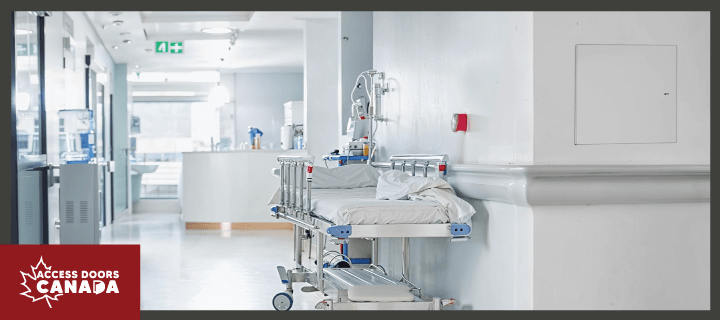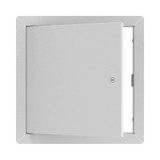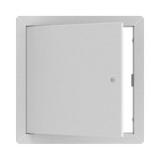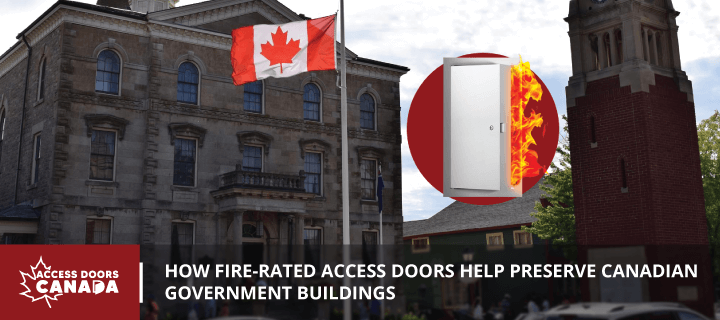How Fire-Rated Access Doors Help Preserve Canadian Government Buildings
Fire can spread fast, and in government buildings, that’s a big problem.
Whether it’s an electrical fault in a mechanical room or a fire breaking out in a storage area, flames and smoke can move quickly, putting documents, infrastructure, and critical services at risk.
This is where fire-rated access doors come in. When placed in key locations, they keep critical areas from being affected too quickly and help prevent small incidents from turning into widespread damage.
Fire Risks in Government Buildings
Government buildings serve many purposes, from public offices to high-security facilities. With busy hallways, secure zones, and storage areas filled with important documents, even a small fire can cause major disruptions.
Many buildings house archives, electrical systems, and restricted areas where damage could have long-term consequences. A fire in an electrical room could shut down critical systems, while one in an archive could destroy irreplaceable records. Some spaces are designed to be off-limits to the public, making fire containment even more important.
That’s why Canada’s National Building Code includes fire-related requirements to help limit damage. The right materials and design choices can slow down the fire, giving people more time to respond and minimizing disruptions.
What Are Fire-Rated Access Doors?
Fire-rated access doors are specially designed panels that help slow the spread of fire and smoke for a set period. Built with durable, heat-resistant materials, they are installed in walls, ceilings, and other key areas to create a barrier that prevents fire from moving too quickly through a building.
Unlike standard access doors, these models go through rigorous testing to meet fire-rating requirements. Some are designed to withstand high temperatures for 45 minutes, while others hold up for over three hours.
One reliable option is the ADC-FW-5050 Fire Rated Insulated Recessed Door with Flange. Built for durability and performance, this door meets fire-rating requirements for both walls and ceilings while maintaining a clean, recessed look.
Here’s why you should check out this product:
- Fire-Rated for Walls and Ceilings: Certified for up to 1.5 hours in walls and 3 hours in ceilings, meeting UL, ULC, and Warnock Hersey standards.
- Heavy-Duty Construction: Made with a 20-gauge steel door and a 16-gauge mounting frame for lasting strength.
- Secure and Easy to Use: Features a concealed hinge and a universal self-latching bolt for reliable access control.
Want to learn more about the best fire-rated access doors and panels for commercial buildings? Check out our blog on the different types of fire-rated access doors suitable for Canadian commercial buildings and find the right fit for your project!
Other Benefits of Fire-Rated Access Doors
Fire-rated access doors also offer several other benefits such as:
- Hidden Access to Critical Systems: Fire-rated access doors blend into walls and ceilings while still allowing easy access to electrical, plumbing, and mechanical systems for maintenance and repairs.
- Durability for High-Traffic Areas: Built with strong materials, these doors hold up against daily wear and tear, making them a long-lasting solution for government buildings.
- Improved Air and Sound Control: Some models come with insulation that helps reduce noise and limit airflow, adding extra functionality beyond fire containment.
- Compliance With Building Codes: Installing fire-rated access doors helps government buildings meet Canada’s National Building Code requirements, ensuring structures are built to the right standards.
Where Are Fire-Rated Access Doors Most Needed?
Fire-rated access doors are best placed in the following areas:
Electrical and Mechanical Rooms
These rooms contain wiring, panels, and heavy equipment that can overheat or spark, increasing the risk of fire. If flames start here, they can quickly spread to other areas of the building.
Regular maintenance and proper containment are essential to prevent electrical failures from turning into larger issues. These rooms are often closed off from public access, but fire hazards inside them require careful planning.
Archives and Document Storage
Government buildings store sensitive records, legal documents, and historical files that are difficult or impossible to replace. A fire in these areas can cause permanent loss of important information and documentation.
Many of these storage spaces are tightly packed with paper and other flammable materials, making them especially vulnerable. Without proper fire control, even a small spark can lead to widespread damage.
Restricted and High-Security Areas
Certain government spaces, such as data centers or classified storage rooms, have limited access, making fire containment a challenge.
These areas often contain valuable assets, sensitive technology, or confidential records that must be preserved. Since access is restricted, careful planning is needed to prevent fire-related disruptions.
Hallways and Stairwells
Fire can move quickly through open pathways, making hallways and stairwells vulnerable. These areas often act as escape routes, so keeping them clear of smoke and flames for as long as possible is important.
Since these spaces connect different sections of a building, fire in one area can easily spread to another. Designing hallways and stairwells with fire containment in mind helps reduce risks in an emergency.
Fire-rated access doors help slow fire in these spaces for a specific time, preventing it from spreading too fast and allowing people more time to evacuate.
Storage and Utility Spaces
Many government buildings have storage rooms filled with furniture, supplies, or chemicals that can fuel a fire. These areas are often tucked away, making fire detection slower.
Utility rooms, janitorial closets, and supply areas may not seem like high-risk spaces, but they often contain materials that burn quickly.
Keeping these areas organized and monitored is key to fire prevention.
Choosing the Right Fire-Rated Access Doors
Choosing the right fire-rated access doors ensures they function properly and meet building regulations.
When it comes to fire-rated doors for government buildings in Canada, consider the following factors:
- Fire Rating Duration: Different doors are rated to withstand fire for a set amount of time, such as 45, 90, or 180 minutes. It’s important to match the fire rating to the specific needs of the building.
- Material and Build Quality: Fire-rated access doors are often made from steel or other heat-resistant materials. Choosing a durable option ensures long-term performance, especially in high-use areas.
- Size and Placement: These doors come in various sizes and are designed for different locations, including walls, ceilings, and floors. Selecting the right fit ensures easy installation and proper fire containment.
- Security Features: Some areas require extra security, especially in government buildings. Fire-rated access doors can include locks, tamper-resistant latches, or even keycard access for restricted zones.
Conclusion
Fire-rated access doors play an important role in government buildings by helping to slow the spread of fire and smoke for a set period of time. Installing them in key areas and choosing the right type makes a big difference in fire containment. With the right doors in place, buildings are better equipped to handle fire emergencies.
Need the right access solutions for your building? Access Doors Canada has you covered! Call us at (800) 679-3405, and we’ll help you find the perfect fire-rated access door for your project.









